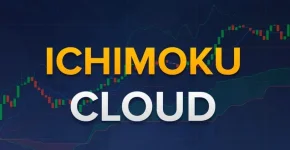- Joined
- Nov 2, 2024
- Messages
- 144
- Reaction score
- 6
- Points
- 18
The Ichimoku Cloud: An Overview
The Ichimoku Cloud is a technical analysis indicator created by Japanese analyst Goichi Hosoda nearly 50 years ago. It functions as a comprehensive system to assess trend direction, support and resistance levels, and potential entry points in the market.
Components of the Ichimoku Cloud
The Ichimoku Cloud comprises five lines, two of which create the cloud itself. The trading strategy based on this tool is generally applied to time frames such as H4 and higher. Here’s a breakdown of its components when displayed on a chart:- Tenkan-sen - The red line, a moving average based on the past nine periods.
- Kijun-sen - The blue line, a moving average for the past 26 periods.
- Chikou Span - The green line, which shows the closing price of the candlestick shifted back by 26 periods.
- Senkou Span A - The yellow line, calculated as the average of Tenkan-sen and Kijun-sen, with a shift of 26 periods.
- Senkou Span B - The purple line, calculated as a moving average over a period 3-4 times longer than Kijun-sen, also shifted by 26 periods.
How to Use the Ichimoku Cloud for Trading
Trading Signals
Ichimoku-based strategies rely on the relative position of these lines and the current price in relation to the Cloud. Here are some popular approaches:- Trading Above or Below the Cloud: If the price is above the Cloud, it’s generally considered a buy signal, with the Cloud edges acting as support levels. Conversely, if the price is below, it indicates a sell signal, with the edges acting as resistance.
- Kijun-sen as a Trend Indicator: Kijun-sen (blue line) serves as the main trend indicator. When the price is above it, an uptrend is indicated. If the price moves below Kijun-sen, it suggests a potential trend reversal, signaling the need to close buy orders.
- Crossover Signals: The Kijun-sen and Tenkan-sen lines work like moving averages, generating buy or sell signals when they cross each other. This technique is most effective in trending markets, so additional filtering can help minimize market noise.
Trading in Sideways Markets
When the price is within the Cloud, it signals a flat or sideways trend, especially if Tenkan-sen (red line) appears horizontal. In such conditions, it’s best to avoid trades, as sideways movements often result in more losses than gains.Additional Signals and Advanced Use
While Ichimoku signals appear frequently, they often require further confirmation. For example, when looking for a buy opportunity, the price should be above the Cloud (indicating a bullish trend) with Senkou Span A above Senkou Span B. After a minor price correction down to Kijun-sen, the price should cross above Kijun-sen again, signaling a continuation of the uptrend.For a sell trade, opposite conditions apply: the price should be below the Cloud, with Senkou Span B dominating Senkou Span A. After an upward correction that touches Kijun-sen, a new cross below Kijun-sen from top to bottom provides a sell signal.





